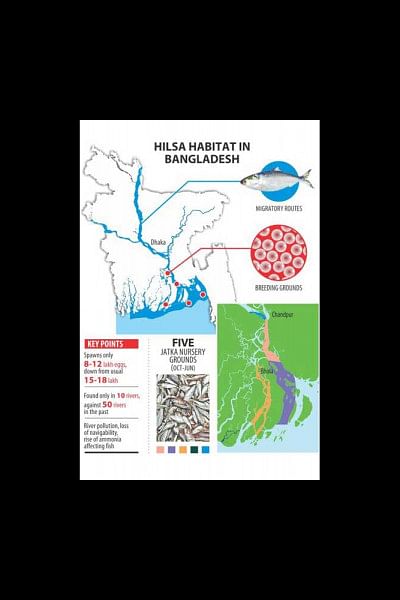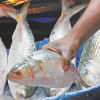Hilsa spawning less and less

To us Bangalees, hilsa isn't just a fish. It's an integral part of our culture and heritage. Be it fried or cooked with mustard, hilsa is a must in Pahela Baishakh celebrations. But they aren't anymore safe in our rivers, home to world's 60pc hilsa. This four-part series focuses on the existential crisis, changing habitat and ways to conserve this much coveted fish.
Hilsa's capacity to spawn in Bangladesh rivers has decreased significantly over the past few years, meaning we will get to have less of this mouthwatering fish in the coming years if the trend continues.
Researchers are working to find exactly why this mystique fish is spawning fewer eggs, but they believe river pollution, loss of their navigability, food shortages and saltwater intrusion due to climate change are to blame.
On an average, a matured hilsa spawns some 15 to 18 lakh eggs at a time, but it has come down to eight to 12 lakh in recent years, according to a research by Bangladesh Fisheries Research Institute (BFRI).
"We have been doing the count since 2011 and found this clear change in hilsa's spawning pattern," said BFRI Director Anisur Rahman, who is leading the government-funded research that began in 2011 and is ongoing.
A matured hilsa releases maximum 21 lakh and minimum three lakh eggs at a time. But a very small number of them are hatched out, and even a smaller number of fry survives and becomes mature to spawn, Anisur added.
For the past several years, extremely polluted waters of the Buriganga, Shitalakkhya, Turag and Bangshi rivers have been flowing into the Meghna, the main breeding ground of the national fish. Moreover, BFRI test has found that ammonia, a colourless compound of nitrogen and hydrogen, is increasing in the Meghna.
Tolerance level varies among fish species, but ammonia toxicity is believed to be a cause of unexplained losses in fish hatcheries. Excess ammonia may accumulate and cause alteration of metabolism.
"If ammonia increases in water, it causes a significant impact on the food system of hilsa," said the BFRI director, indicating that this could explain the fall in hilsa spawning.
Even in the 1980s, hilsha was available in more than 50 rivers, including all the big ones, of the country. But now they are found only in 10 rivers -- Padma, Meghna, Jamuna, Paira, Tentulia, Bishkhali, Shibsa, Baleshwar, Kirtankhola and Arial Kha, experts say.
The fish has virtually vanished from the 170-km Karnaphuli river. Besides, they cannot be found anymore in the Shitalakkhya, Kaliganga and the rivers of the Ganges river system, including the Nabaganga, Garai and Madhumati, since India started withdrawing water of the Ganges through the Farakka barrage after the Liberation War.
Hilsas prefer around 25-feet-deep water and strong currents to go against, but for loss of navigability, they have stopped migrating to many rivers, according to experts.
GC Halder, a retired scientist of BFRI, said impacts of climate change such as saltwater intrusion and rise in sea-level might not have affected hilsa movement much but pollution and loss of navigability in rivers were doing the main damage.
Hilsa can survive in both saline and sweet waters.
"However, because of the saltwater intrusion, hilsa may shift its spawning grounds to deeper inland water as it needs sweet water for releasing eggs," he said.
Also, they might have travelled to sweet waters in neighbouring countries through the sea for laying eggs, Halder added.
Last year, scientists noticed a significant change in the spawning habit of hilsa during the full moon in the Bangla month of Ashwin when around 70 percent of the fish was supposed to lay eggs.
But a large number of hilsa did not spawn even 10 days after the full moon. Usually, they release eggs between three days before and seven days after the full moon in Ashwin (September or October).
Normally, most hilsa travels from the sea to sweet water weeks before the full moon. They then swim towards the rivers in the upstream, including the Padma, Brahmaputra and Surma, while taking food. When the full moon nears, they travel back to the estuary where sweet, saline and muddy waters merge.
Father and mother hilsas swim back to the sea after the spawning season while the baby fish, after hatching, travel towards sweet waters in the upstream and remain there until May or June before going to the sea. When the next spawning season comes, the baby fishes that have matured by this time come to sweet waters to release eggs with their parents and elders. Their usual lifespan is three to five years.
Anisur Rahman, the BFRI director, thinks hilsa might stop coming to Bangladesh rivers altogether and start migrating to those of Myanmar and India if hilsa fry are not conserved and the problems facing the silver fish are not addressed.

 For all latest news, follow The Daily Star's Google News channel.
For all latest news, follow The Daily Star's Google News channel. 





Comments